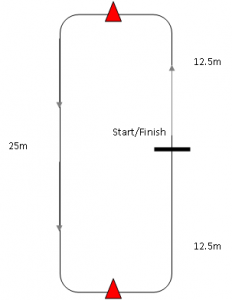
Five Star Five Steps: Primary
Sprint:
Sprinting is the most basic of athletics events. In its fundamental form it consists of two elements; leg speed, referred to as cadence, and stride length. The rest of the body – trunk shoulders and arms – must also be under control so that the force exerted by the legs produces optimal drive through the body.
- First, get the children used to moving the legs quickly on the spot. This can be done in 10 second bursts. The emphasis should be keeping the body straight, head up and driving the arms and legs rhythmically in a controlled manner. (See video)
- Introduce natural acceleration by instructing them to lean forward after the 10th step and run as fast as they can over about 10-15m. The optimal acceleration position requires some forward lean, which the children will do naturally. It may help them to understand this by getting them into pairs and ask if this is happening with their partner.
- Although teaching a crouched start is not recommended for this age group, the basic elements can still be introduced via playful activities. For example, the teacher can instruct the children to lie on their backs with their heads in the direction of the run, behind a start line. On the command “GO”, they sprint forward as quickly as possible to a marker at 10 to 15m. Without instruction they will automatically take up a reasonable start position with their hands approximately 40-50cm behind the start line, with a forward lean position. Again, partner work could be used so that children can observe this happening for themselves. In order to create a challenge, teachers could handicap the start position so that the slower children have a chance to get across the 10-15m line ahead of naturally faster runners.
- In order to maintain speed whilst sprinting, relaxation is essential. For those children who don’t do this naturally, some teaching is required. Get the children to practice the correct arm movement with an on the spot drill – approx 45 degree angle at the elbow, pulling the elbow straight back smartly, whilst keeping shoulders relaxed and straight. Then translate this action to full sprinting over 40 to 50m. Point out any excessive upper body rotation and get the child to repeat the drill keeping the trunk steady. Again, pairs work might help children’s awareness of what their arms and upper body are doing.
- The fifth and last phase – and most technical – is the foot and leg movements. The children need to understand that real power and speed comes from effectively driving down and backwards into the ground, which produces good stride length and a high knee action. To help children to develop this action, emphasize high knees by sprinting over SAQ hurdles set at an appropriate distance for the natural stride length of the child.
Heath & Safety
As with all events, footwear and ground surface is important. Care is needed to ensure that shoes are tied and give the appropriate grip. When running on wet grass, tight turns are best avoided.
The Test
To test speed and acceleration within the limitations of a school environment, a short course with two cones approximately 25m apart (see diagram). The starting line is halfway between the cones. The instructions on your marks and the start signal (whistle or “GO”) should be used. To ensure that the correct acceleration pattern is used the athletes can be asked to touch the ground behind the cones at each turn. Times and point scores are below.
To add some additional fun the test can be run as a pursuit race between matched pairs. (Two children on the start line, but facing in opposite directions; on GO, each tries to catch the other around the course over 1 or 2 laps, as agreed. The winner is the one who gets nearest to the other. The course can be shorted to make this more fun. A number of tests can be run simultaneously to ensure that class are kept active. It is also possible to do this with small hurdles to run over.
See instructional video below.
Scoring (distribution of times within a cohort have been factored in to the scoring system)
13 secs or better; 5 points
14 secs or better; 4 points
14.5 secs or better 3 points
16 secs or better 2 points
19 secs or better 1 point